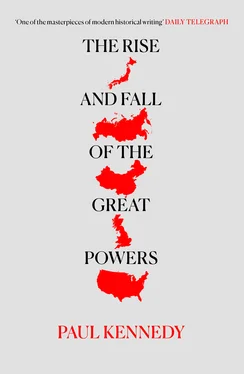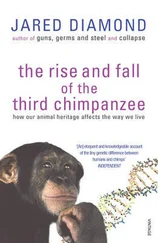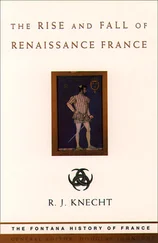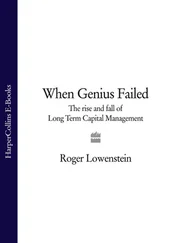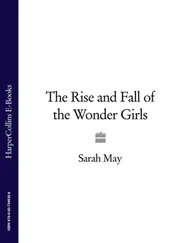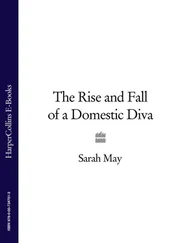The Postwar International Order
The Challengers
The Offstage Superpowers
The Unfolding Crisis, 1931–42
STRATEGY AND ECONOMICS TODAY AND TOMORROW
7. Stability and Change in a Bipolar World, 1943–80
‘The Proper Application of Overwhelming Force’
The New Strategic Landscape
The Cold War and the Third World
The Fissuring of the Bipolar World
The Changing Economic Balances, 1950–80
8. To the Twenty-first Century
History and Speculation
China’s Balancing Act
The Japanese Dilemma
The EEC – Potential and Problems
The Soviet Union and Its ‘Contradictions’
The United States: the Problem of Number One in Relative Decline
EPILOGUE
NOTES
FOOTNOTES
BIBLIOGRAPHY
INDEX
ACKNOWLEDGEMENTS
ABOUT THE AUTHOR
ABOUT THE PUBLISHER
1. World Power Centres in the Sixteenth Century
2. The Political Divisions of Europe in the Sixteenth Century
3. Charles V’s Inheritance, 1519
4. The Collapse of Spanish Power in Europe
5. Europe in 1721
6. European Colonial Empires, c. 1750
7. Europe at the Height of Napoleon’s Power, 1810
8. The Chief Possessions, Naval Bases, and Submarine Cables of the British Empire, c. 1900
9. The European Powers and Their War Plans in 1914
10. Europe After the First World War
11. Europe at the Height of Hitler’s Power, 1942
12. Worldwide US Force Deployments, 1987
1. Increase in Military Manpower, 1470–1660
2. British Wartime Expenditure and Revenue, 1688–1815
3. Populations of the Powers, 1700–1800
4. Size of Armies, 1690–1814
5. Size of Navies, 1689–1815
6. Relative Shares of World Manufacturing Output, 1750–1900
7. Per Capita Levels of Industrialization, 1750–1900
8. Military Personnel of the Powers, 1816–80
9. GNP of the European Great Powers, 1830–90
10. Per Capita GNP of the European Great Powers, 1830–90
11. Military Expenditures of the Powers in the Crimean War
12. Total Population of the Powers, 1890–1938
13. Urban Population of the Powers and as Percentage of the Total Population, 1890–1938
14. Per Capita Levels of Industrialization, 1880–1938
15. Iron/Steel Production of the Powers, 1890–1938
16. Energy Consumption of the Powers, 1890–1938
17. Total Industrial Potential of the Powers in Relative Perspective, 1880–1938
18. Relative Shares of World Manufacturing Output, 1880–1938
19. Military and Naval Personnel of the Powers, 1880–1914
20. Warship Tonnage of the Powers, 1880–1914
21. National Income, Population, and per Capita Income of the Powers in 1914
22. Industrial/Technological Comparisons of the 1914 Alliances
23. UK Munitions Production, 1914–18
24. Industrial/Technological Comparisons with the United States but Without Russia
25. War Expenditure and Total Mobilized Forces, 1914–19
26. World Indices of Manufacturing Production, 1913–25
27. Defence Expenditures of the Great Powers, 1930–8
28. Annual Indices of Manufacturing Production, 1913–38
29. Aircraft Production of the Powers, 1932–9
30. Shares of World Manufacturing Output, 1929–38
31. National Income of the Powers in 1937 and Percentage Spent on Defence
32. Relative War Potential of the Powers in 1937
33. Tank Production in 1944
34. Aircraft Production of the Powers, 1939–45
35. Armaments Production of the Powers, 1940–3
36. Total GNP and per Capita GNP of the Powers in 1950
37. Defence Expenditures of the Powers, 1948–70
38. Nuclear Delivery Vehicles of the Powers, 1974
39. Production of World Manufacturing Industries, 1830–1980
40. Volume of World Trade, 1850–1971
41. Percentage Increases in World Production, 1948–68
42. Average Annual Rate of Growth of Output per Capita, 1948–62
43. Shares of Gross World Product, 1960–80
44. Population, GNP per Capita, and GNP in 1980
45. Growth in Real GNP, 1979–83
46. Kilos of Coal Equivalent and Steel Used to Produce $1,000 of GDP in 1979–80
47. Estimated Strategic Nuclear Warheads
48. NATO and Warsaw Pact Naval Strengths
49. US Federal Deficit, Debt, and Interest, 1980–5
1. The Relative Power of Russia and Germany
2. GDP Projections of China, India, and Certain Western European States, 1980–2020
3. Grain Production in the Soviet Union and China, 1950–84
This is a book about national and international power in the ‘modern’ – that is, post-Renaissance – period. It seeks to trace and to explain how the various Great Powers have risen and fallen, relative to each other, over the five centuries since the formation of the ‘new monarchies’ of western Europe and the beginnings of the transoceanic, global system of states. Inevitably, it concerns itself a great deal with wars, especially those major, drawn-out conflicts fought by coalitions of Great Powers which had such an impact upon the international order; but it is not strictly a book about military history. It also concerns itself with tracing the changes which have occurred in the global economic balances since 1500; and yet it is not, at least directly, a work of economic history. What it concentrates upon is the interaction between economics and strategy, as each of the leading states in the international system strove to enhance its wealth and its power, to become (or to remain) both rich and strong.
The ‘military conflict’ referred to in the book’s subtitle is therefore always examined in the context of ‘economic change’. The triumph of any one Great Power in this period, or the collapse of another, has usually been the consequence of lengthy fighting by its armed forces; but it has also been the consequence of the more or less efficient utilization of the state’s productive economic resources in wartime, and, further in the background, of the way in which that state’s economy had been rising or falling, relative to the other leading nations, in the decades preceding the actual conflict. For that reason, how a Great Power’s position steadily alters in peacetime is as important to this study as how it fights in wartime.
The argument being offered here will receive much more elaborate analysis in the text itself, but can be summarized very briefly:
The relative strengths of the leading nations in world affairs never remain constant, principally because of the uneven rate of growth among different societies and of the technological and organizational breakthroughs which bring a greater advantage to one society than to another. For example, the coming of the long-range gunned sailing ship and the rise of the Atlantic trades after 1500 was not uniformly beneficial to all the states of Europe – it boosted some much more than others. In the same way, the later development of steam power and of the coal and metal resources upon which it relied massively increased the relative power of certain nations, and thereby decreased the relative power of others. Once their productive capacity was enhanced, countries would normally find it easier to sustain the burdens of paying for large-scale armaments in peacetime and of maintaining and supplying armies and fleets in wartime. It sounds crudely mercantilistic to express it this way, but wealth is usually needed to underpin military power, and military power is usually needed to acquire and protect wealth. If, however, too large a proportion of the state’s resources is diverted from wealth creation and allocated instead to military purposes, then that is likely to lead to a weakening of national power over the longer term. In the same way, if a state overextends itself strategically – by, say, the conquest of extensive territories or the waging of costly wars – it runs the risk that the potential benefits from external expansion may be outweighed by the great expense of it all – a dilemma which becomes acute if the nation concerned has entered a period of relative economic decline. The history of the rise and later fall of the leading countries in the Great Power system since the advance of western Europe in the sixteenth century – that is, of nations such as Spain, the Netherlands, France, the British Empire, and currently the United States – shows a very significant correlation over the longer term between productive and revenue-raising capacities on the one hand and military strength on the other.
Читать дальше
